massage and bodywork professionals
a community of practitioners
More than two million Americans suffer either from back pain or a form of sciatica that is often misdiagnosed and improperly treated. Many suffer from pain for months or years without a proper diagnosis. I work with these symptoms so frequently that I have noticed some common characteristics with this all-too-common pain complaint.
The most common characteristic I find are aggravated myofascial trigger points (TrPs) in the piriformis muscle. Piriformis trigger points are often confused for a herniated disc, sciatica, or other back issues, and many sufferers undergo unnecessary and costly tests, injections, and surgeries.
What is the piriformis?
The piriformis muscle is a small external rotator of the hip whose function primarily is to turn the knee and foot outward. It lies deep within the gluteal muscles, originates from the sacral spine, and attaches to the greater trochanter of the femur — the big bony “bump” on the outside top of the thigh. The sciatic nerve passes beneath through an opening called the sciatic notch.
Hip abduction.
In weight bearing activities, foot loaded, the pirifomis is often needed to control rapid medial rotation of the thigh — for example, as the foot strikes the ground during walking or running, the knee turns inward.
Piriformis Trigger Points (TrPs)
Symptoms
The myofascial pain component includes pain in the low back, groin, buttock, and hip. A TrP may cause the muscle to compress and irritate the sciatic nerve, causing the pain to travel along the course of the nerve. The pain may radiate down the back of the leg and into the hamstrings, the calf muscles, and possibly the foot. The pain may initially be confused with a hamstring strain. Weakness, stiffness and a general restriction of movement are also quite common. Tingling, numbness, or shooting pains down the leg can also be experienced. Symptoms tend to be aggravated by prolonged sitting or by intense activity.
Piriformis TrPs are predominantly caused by a shortening or tightening of the piriformis muscle. Piriformis TrPs are commonly associated with sports that require a lot of running, change of direction, or weight-bearing activity. Piriformis TrPs can result from acute overload (as when catching oneself from a fall), from repetitive overload (as with the rapid internal rotation of the weight bearing experienced by walkers and runners with poor biomechanics), or from sustained overload (as when holding the leg bent and turned outward for prolonged periods while driving a car or working at a desk). Sciatic pain from piriformis TrPs is also a common complaint during pregnancy.
The piriformis muscle is responsible for the symptoms of pain by projecting pain from activation of the TrPs and by nerve entrapment upon the sciatic nerve. Once TrPs are activated, the piriformis muscle begins to put pressure on the sciatic nerve. The sciatic nerve runs under (and sometimes through) the piriformis muscle on its way out of the pelvis. The piriformis muscle can squeeze and irritate the sciatic nerve in this area, leading to the symptoms of sciatica.
Treatment and Prevention
The first two steps in treating piriformis TrPs can provide the most significant and immediate relief: deep tissue massage with stretching of the external rotators of the hip. Deep tissue massage techniques such as myofascial release and trigger point therapy are highly effective at reducing active trigger points. Once the TrP is released, there will be a significant reduction in pain.
Following up the massage with flexibility training will help loosen the muscle and help prevent a return of the TrP. I have found that it takes between four and ten massage sessions to move out of the acute pain phase from piriformis TrPs. It may be shorter or longer depending on the cause and severity of the initial injury.
For long-term prevention of piriformis TrPs, self myofascial release and flexibility will be your most invaluable tools. Below are some pictures of how to relieve piriformis TrPs using a ball (preferably a tennis ball for beginners) and how to stretch the piriformis muscle and other external rotators of the hip. With each stretch it is important to breathe into the stretch and only stretch to slight discomfort … NOT PAIN.
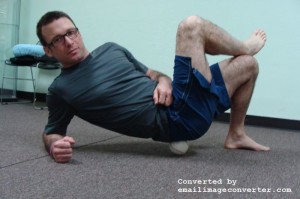
Self trigger point therapy using a ball. Find a painful spot in the glutes, relax your body into the ball, hold position for 30-60 seconds or until you notice a significant reduction in pain. Move to the next painful spot. 5-10 minutes total.
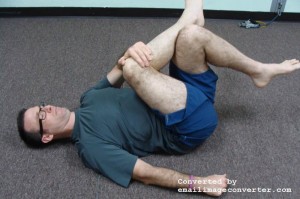
Lying piriformis stretch. Place the leg you are stretching mid-calf on opposite knee. Pull opposite knee towards chest while at the same time pulling the knee of stretching leg towards opposite shoulder. Hold 30-60 seconds.
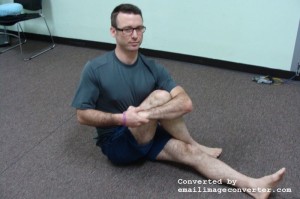
Seated gluteal stretch. Cross the leg being stretched over opposite leg. Wrap opposite elbow around the knee and pull towards opposite leg. Keep you back straight. Hold 30-60 seconds.
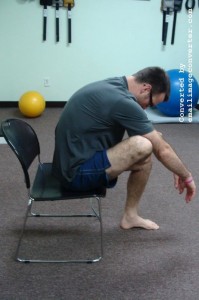
Seated gluteal stretch. Place ankle of leg being stretch on opposite knee. Throw both hands over your leg, take a deep breath, and, as you exhale, allow your chest to drop toward the floor. Hold 30-60 seconds.
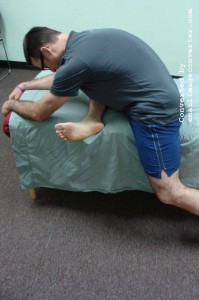
Modified pigeon pose. Place leg being stretched on a table, couch, or bed with knee bent and opposite leg resting on the floor. Drop your chest toward to table. Hold 30-60 seconds.
Other suggestions to prevent Piriformis TrPs
Our bodies were designed to move. It is important to keep moving. Try not to sit down for more than an hour at a time. Stand up, take breaks, go for a walk, and stretch your body throughout the day. Lack of movement causes muscle dysfunction. Proper movement is key to an active healthy life. With an exercise program that focuses on functional movement patterns with core strength and stabilization, regular full body massage (self massage or professional), and full body flexibility you will reduce your chances for chronic pain and injuries.
Running/walking
Change the way you walk and run. Heel strike is the most common dysfunction in running/walking gait. As soon as the heel strikes the ground, the knee rapidly moves into external rotation followed by rapid inward rotation. This places repetitive trauma on the piriformis muscle and leads to TrP formation and activation. I suggest hiring a coach who instructs forefoot or midfoot strike running form.
Replace your shoes. Modern running shoes promote heel strike. I advocate shoes with as little cushion and arch support as your body can handle.
Be smart with a shoe and form transition. Your body has adapted to how you walk and the shoes you wear. A fast transition without proper instruction and training raises your risk of significant injury. Below is a great article about what is wrong with your running/walking shoes.
What Happens to Our Foot When We Wear Traditional Running Shoes
Jesse James Retherford is a certified personal trainer and licensed massage therapist. For over 12 years, Jesse has been passionate about helping his clients reach their fitness and health goals.
Jesse specializes in chronic pain and injury management, movement assessment, corrective exercise, and advanced sports conditioning.
Jesse offers personalized programs designed to improve performance and efficiency, reduce chances of injury, and allow you to move pain free so you can re-engage fully with your life.
Reposting is permitted as long as it is posted in its entirety, including links, and author’s bio.
Views: 607
Comment
© 2024 Created by ABMP.
Powered by
![]()
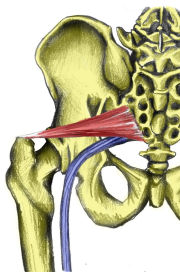

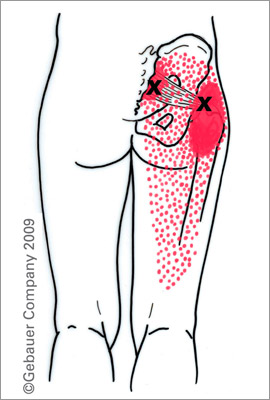
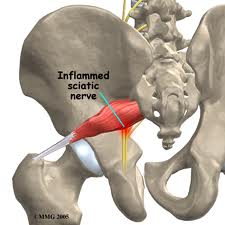
You need to be a member of massage and bodywork professionals to add comments!
Join massage and bodywork professionals